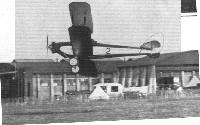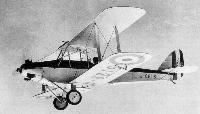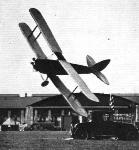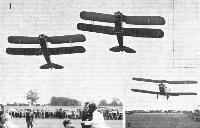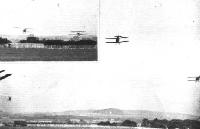
Варианты
- De Havilland - Moth / D.H.60 - 1925 - Великобритания
- De Havilland - Genet Moth - 1926 - Великобритания
- De Havilland - Moth Seaplane - 1926 - Великобритания
- De Havilland - Gipsy Moth / Moth X - 1928 - Великобритания
- De Havilland - Moth Coupe - 1928 - Великобритания
- De Havilland - Moth Major / D.H.60GIII - 1932 - Великобритания
de Havilland DH.60 Moth
<...>
Одну машину построили для проведенного в 1926 году Министерством авиации конкурса легких самолетов в Лимпне, оснастив ее звездообразным мотором Armstrong Siddeley Genet мощностью 75 л.с. (60 кВт). Позже ее использовали для высшего пилотажа. Модель следующего года DH.60X снова улучшили, увеличив размах и присвоив название Cirrus II Moth.
Были установлены рекорды, совершены дальние перелеты, заказы продолжали поступать. Центральная летная школа ВВС закупила шесть экземпляров машины с моторами Genet, авиакорпус Ирландии - еще две.
<...>
Описание:
- de Havilland DH.60 Moth
- Flight, September 1926
British Light ‘Plane Development & Lympne Meeting
Фотографии
-
Flight 1926-09 / Flight
No. 2. THE DE HAVILLAND "MOTH": Side view.
-
Flight 1928-06 / Flight
Регистрационный номер: J8816 [5] DE HAVILLAND "GENET-MOTH": Light Training Biplane, with Armstrong-Siddeley"Genet" Engine.
-
Flight 1926-09 / Flight
No. 2. THE DE HAVILLAND "MOTH": Three-quarter front view.
-
Flight 1926-09 / Flight
Making Quite Sure: Professor Low sealing the tank of the de Havilland "Moth."
-
Flight 1926-09 / Flight
THE DE HAVILLAND TEAM: From left to right, H. Cantrill, R. Brant, E. Mitchell, Capt. de Havilland, W. Hales (Armstrong-Siddeley), and Capt. H. Broad.
-
Flight 1926-09 / Flight
THE LANCASHIRE AIR PAGEANT: The Avro "Avian" and the de Havilland "Moth," both with "Genet" engines, starting neck-and-neck in the Open Handicap.
Другие самолёты на фотографии: Avro Avian / Type 594/616 - Великобритания - 1926
-
Flight 1927-06 / Flight
THE START OF THE COMPETITION: Some of the competing machines on Sunday morning at the start for Brighton. 2, Broad wastes no time on the de Havilland "Moth."
-
Мировая Авиация 25
Регистрационный номер: J8816 [5] Genet Moth, оснащенный радиальным мотором Armstrong Siddeley Genet, внешне довольно сильно отличался от своих собратьев с двигателями Cirrus. Все построенные самолеты этого типа, за исключением одного, попали в Центральную летную школу RAF.
-
Flight 1926-09 / Flight
Capt. Broad cornering on the de Havilland "Moth" with "Genet" engine in the S.M.M.T. Race. Average speed 94-75 m.p.h.
-
Flight 1927-07 / Flight
"LET'S ALL GO MAD": Sq.-Ldr. J. Noakes is seen "crabbing" on a "Genet-Moth."
-
Flight 1927-07 / Flight
Регистрационный номер: J8820 [2] A "Genet-Moth" performing the unusual stunt of "skating" across the aerodrome on the side of its fuselage.
-
Flight 1928-07 / Flight
Регистрационный номер: J8819 One of the Genet-Moths inverted during one of its climbing rolls in the course of the same remarkable performance by Flying Officers Boyle and Atcherley.
-
Flight 1926-09 / Flight
ELIMINATING TRIALS: In the lower photograph the de Havilland "Moth" is seen doing its get-off test, while on the right the same machine is seen in the landing test. Note the mechanic standing up to act as "air brake."
-
Flight 1929-10 / Flight
Регистрационный номер: J8816 [5], J8820 [2] R.A.F. Genet Moths in which Flt. Lt. M. Wiblin and F/O. W. Johnson helped to enliven the meeting.
-
Flight 1928-07 / Flight
EMULATION: (Left) The two Genet-Moths piloted by Flying Officers Boyle and Atcherley in opposite positions; and (right) performing their remarkable slow rolls very low across the Blackpool aerodrome.
-
Flight 1930-07 / Flight
Start of the Headquarters Race (Genet Moths).
-
Flight 1929-07 / Flight
EVENT 8. FLIGHT AEROBATICS: Three Genet-Moths of the Central Flying School, piloted by Flt.-Lieut. J. S. Chick, M.C., and F./O's. D.A.Boyle and W. E. P. Johnson, flying in formation across the aerodrome upside down.
-
Aeroplane Monthly 1978-10 / A.Jackson - D.H.60 Moth /RAF Piston Trainers/ (3)
Регистрационный номер: J8816 [5], J8818 [2], G-EDCA [2] The Genet Moth Display Flight of the CFS takes off at the Hendon RAF Display on July 2, 1927, with J8818/G-EDCA leading.
-
Flight 1927-07 / Flight
Регистрационный номер: J8816 [5], J8818 [2], G-EDCA [2] THE BIRMINGHAM AIR PAGEANT: The first R.A.F. event at the Pageant was a display of simultaneous aerobatics by five "Genet-Moths" from the Central Flying School. The lower picture shows them taking off while the top picture shows how close each machine was to the other.
-
Flight 1927-07 / Flight
AEROBATICS BY "GENET-MOTHS": Five instructors from the Central Flying School "evoluting" together. In the upper photograph the machines are just commencing a loop. On the right they are seen upside down. Below, in formation.
-
Flight 1927-07 / Flight
"THE DOUBLE BUNT:" The "Genet-Moths'" turn at the Birmingham Pageant. In the large picture the "Moths" are seen turning upside down after diving - the machine on extreme right is just turning over from the dive. Inset, a simultaneous half-roll.
-
Flight 1926-09 / Flight
THE RACE FOR THE GROSVENOR CHALLENGE CUP: No less than 21 machines faced the starter for this race, a record number. The result was that machines frequently got bunched together at the turning points. Our photograph show one of some such incidents. 2, shows the wing tips of the Cranwell, the Hawker "Cygnet," the Blackburn "Bluebird," and one of the D.H. "Moths" heading for the Postling turning point.
Другие самолёты на фотографии: Blackburn Bluebird / L.1 - Великобритания - 1924Comper Cranwell IV / CLA.4 - Великобритания - 1926Hawker Cygnet - Великобритания - 1924
-
Aeroplane Monthly 1981-09 / A.Wheeler - The Bournemouth Easter Meeting
GOOD HANDICAPPING: Four machines approaching the finishing line in the first heat of the Holiday Final Handicap on Easter Monday. The machines are, in the order of finishing: OU (Sempill), QL (Cantrill), JT (Openshaw), and KQ (Hamersley).
Two Moths, a Widgeon and an Avro 504 approach the finishing line in another race.Другие самолёты на фотографии: Avro Avian / Type 594/616 - Великобритания - 1926Avro Avro 504N - Великобритания - 1920Westland Widgeon - Великобритания - 1924
-
Flight 1927-03 / Flight
SOME OF THE MACHINES AT NORWICH: The photograph shows a Vickers "Virginia" coming in to land over a line of "Moths" which are having their tanks filled.
-
Flight 1926-09 / Flight
LINE UP FOR THE S.M.M.T. RACE: From left to right the machines are: de Havilland "Moth," Avro "Avian," Farnborough "Cygnet," Parnall "Pixie," and Bristol "Brownie." This race was won by Hinkler on the Avro "Avian," at an average speed of 90 m.p.h.
Другие самолёты на фотографии: Avro Avian / Type 594/616 - Великобритания - 1926Bristol Brownie / Type 91 - Великобритания - 1924Hawker Cygnet - Великобритания - 1924Parnall Pixie - Великобритания - 1923
-
Flight 1928-08 / Flight
WINNIPEG FLYING CLUB: Left, Mrs. J. Bracken, who christened the first D.H. "Moth" belonging to the Winnipeg Club, landing from the machine after a flight with Mr. Michael de Blicquy, and receiving a bouquet from the Chairman, Mr. Roy S. Parkhill, and right, Mr. C. W. ("Speed") Holman, operating manager of North Western Airways, Inc. St. Pauls, Minn., thrilled the crowd with his flying at the opening of the Winnipeg Club. He is noted for his record loops.
- Фотографии






